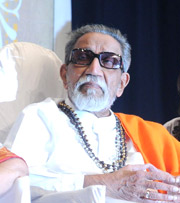Bal Thackeray | |
|---|---|
 Thackeray in 2012 | |
| Leader (Pramukh) of Shiv Sena | |
| In office 19 June 1966 – 17 November 2012 | |
| Preceded by | position created |
| Succeeded by | Uddhav Thackeray |
| Editor-in-chief of Saamana | |
| In office 23 January 1988 – 20 June 2006 | |
| Preceded by | office established |
| Succeeded by | Uddhav Thackeray |
| Co-founder and Editor-in-chief of Marmik | |
| In office 13 August 1960 – 17 November 2012 | |
| Preceded by | office established |
| Succeeded by | Uddhav Thackeray |
| Personal details | |
| Born | Bal Keshav Thackeray 23 January 1926 Poona, Bombay Presidency, British India (present-day Pune, Maharashtra, India) |
| Died | 17 November 2012 (aged 86) Mumbai, Maharashtra, India |
| Nationality | British Indian (1926-1947) Indian (1947-2012) |
| Political party | Shiv Sena |
| Other political affiliations | National Democratic Alliance (from 1998) |
| Spouse | [1] |
| Children | 3, including Uddhav Thackeray |
| Parents |
|
| Relatives | Aaditya Thackeray (grandson) Raj Thackeray (nephew) Thackeray Family |
| Residence(s) | Matoshree Bunglow, Bandra, Mumbai |
| Occupation | |
| Known for | Marathi regionalism Hindutva |
| Nicknames |
|
Bal Keshav Thackeray (Marathi pronunciation: [baːɭ̆ keːʃəʋ ʈʰaːk(ə)ɾeː]; 23 January 1926 – 17 November 2012), also known as Balasaheb Thackeray, was an Indian cartoonist and politician who founded the Shiv Sena, a right-wing pro-Marathi and Hindu nationalist party active mainly in the state of Maharashtra.[2]
Thackeray began his professional career as a cartoonist with the English-language daily, The Free Press Journal in Bombay, but he left the paper in 1960 to form his own political weekly, Marmik.[3] His political philosophy was largely shaped by his father Keshav Sitaram Thackeray, a leading figure in the Samyukta Maharashtra (United Maharashtra) movement, which advocated the creation of a separate linguistic state for Marathi speakers. Through Marmik, Bal Thackeray campaigned against the growing influence of non-Marathis in Mumbai.[3]
He had a large political influence in the state, especially in Mumbai.[4] An inquiry report by Human Rights Watch, submitted to the government found that Thackeray and Chief Minister of Maharashtra Manohar Joshi incited members of the Shiv Sena to commit violence against Muslims during the 1992–1993 Bombay riots.[5][6]
In the late 1960s and early 1970s, Thackeray built the Shiv Sena with help of Madhav Mehere, Chief Attorney for Trade Union of India, Babasaheb Purandare, historian for Govt of Maharashtra and Madhav Deshpande, Head Accountant for Shiv Sena. These three individuals to a large extent were responsible for the success of Shiv Sena and stability of politics in Mumbai till 2000 to ensure it grows into an economic power center.[7] Thackeray was also the founder of the Marathi-language newspaper Saamana.[8] After the riots of 1992–93, he and his party took a Hindutva stance. In 1999, Thackeray was banned from voting and contesting in any election for six years on the recommendations of the Election Commission for indulging in seeking votes in the name of religion. Thackeray was arrested multiple times and spent a brief stint in prison, but he never faced any major legal repercussions.[9] Upon his death, he was accorded a state funeral, at which many mourners were present.[10][11] Thackeray did not held any official positions, and he was never formally elected as the leader of his party.[4]
Cite error: There are <ref group=lower-alpha> tags or {{efn}} templates on this page, but the references will not show without a {{reflist|group=lower-alpha}} template or {{notelist}} template (see the help page).
- ^ Cite error: The named reference
purandare1362was invoked but never defined (see the help page). - ^ Berger, Peter; Heidemann, Frank (3 June 2013). The Modern Anthropology of India: Ethnography, Themes and Theory. Routledge. p. 179. ISBN 978-1134061112.
- ^ a b "The legacy of Shiv Sena supremo Bal Thackeray, the tiger of Marathi resurgence". India Today. Retrieved 20 June 2023.
- ^ a b Cite error: The named reference
:0was invoked but never defined (see the help page). - ^ Cite error: The named reference
narula99was invoked but never defined (see the help page). - ^ Cite error: The named reference
flnwas invoked but never defined (see the help page). - ^ Kaminsky, Arnold P.; Long, Roger D. (2011). India Today: An Encyclopedia of Life in the Republic (illustrated ed.). ABC-CLIO. pp. 693–4. ISBN 978-0-313-37462-3. Archived from the original on 5 February 2016. Retrieved 20 June 2015.
- ^ "India". WAN-IFRA. Archived from the original on 10 April 2015. Retrieved 30 September 2012.
- ^ "The Firebrand Who Renamed Bombay: Bal Thackeray (1926–2012)". 17 November 2012 Time World. 17 November 2012. Archived from the original on 23 November 2013. Retrieved 14 June 2013.
- ^ "Bal Thackeray's funeral procession on way to Shivaji Park; lakhs of supporters follow". NDTV.com. Retrieved 5 May 2023.
- ^ "Hundreds of Thousands Mourn Indian Politician Thackeray". The New York Times. 18 November 2012. Archived from the original on 13 November 2017. Retrieved 8 February 2016.